Operational Management & Leadership Analysis: Monsoons Ltd.
VerifiedAdded on 2024/06/03
|34
|5036
|434
Report
AI Summary
This report provides a comprehensive analysis of leadership and management roles within the operational context of Monsoon Accessorize Ltd, a retail organization specializing in clothing and accessories. It defines and compares the roles of leaders and managers, examining their application in various situational contexts using theories like situational leadership, systems leadership, and contingency theory. The report explains key approaches to operations management, emphasizing the importance of achieving business objectives and assessing the impact of the business environment on operational decision-making. Furthermore, it evaluates how leaders and managers can enhance operational efficiencies to meet business goals successfully and analyzes the broader effects of these factors on the business environment and community. The analysis covers store design, supply chain, inventory management, and workforce management, highlighting the role of managers in planning and strategy and the role of leaders in motivating and training staff to deliver positive customer experiences. The report concludes with recommendations for improving decision-making, employee engagement, and overall organizational productivity.
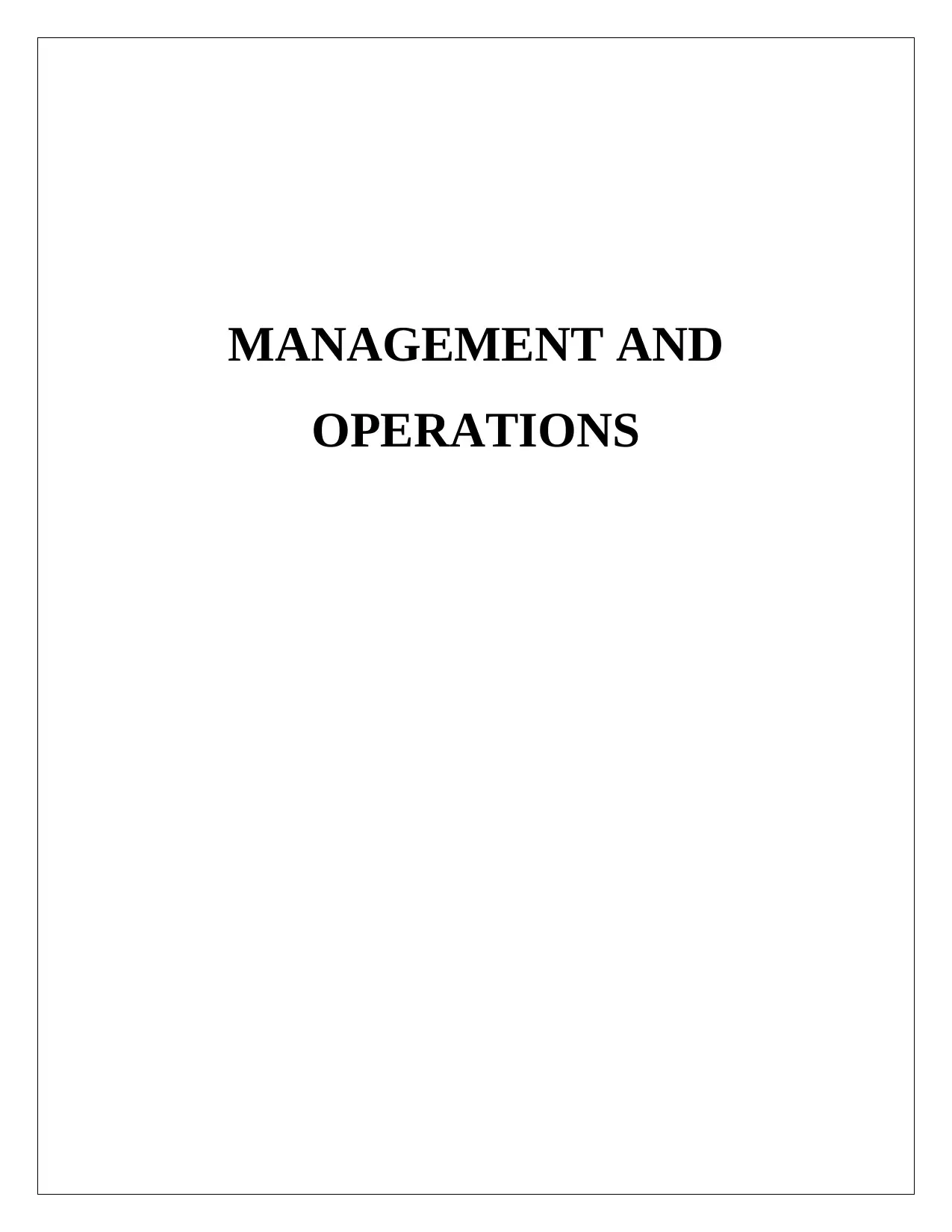
MANAGEMENT AND
OPERATIONS
OPERATIONS
Paraphrase This Document
Need a fresh take? Get an instant paraphrase of this document with our AI Paraphraser
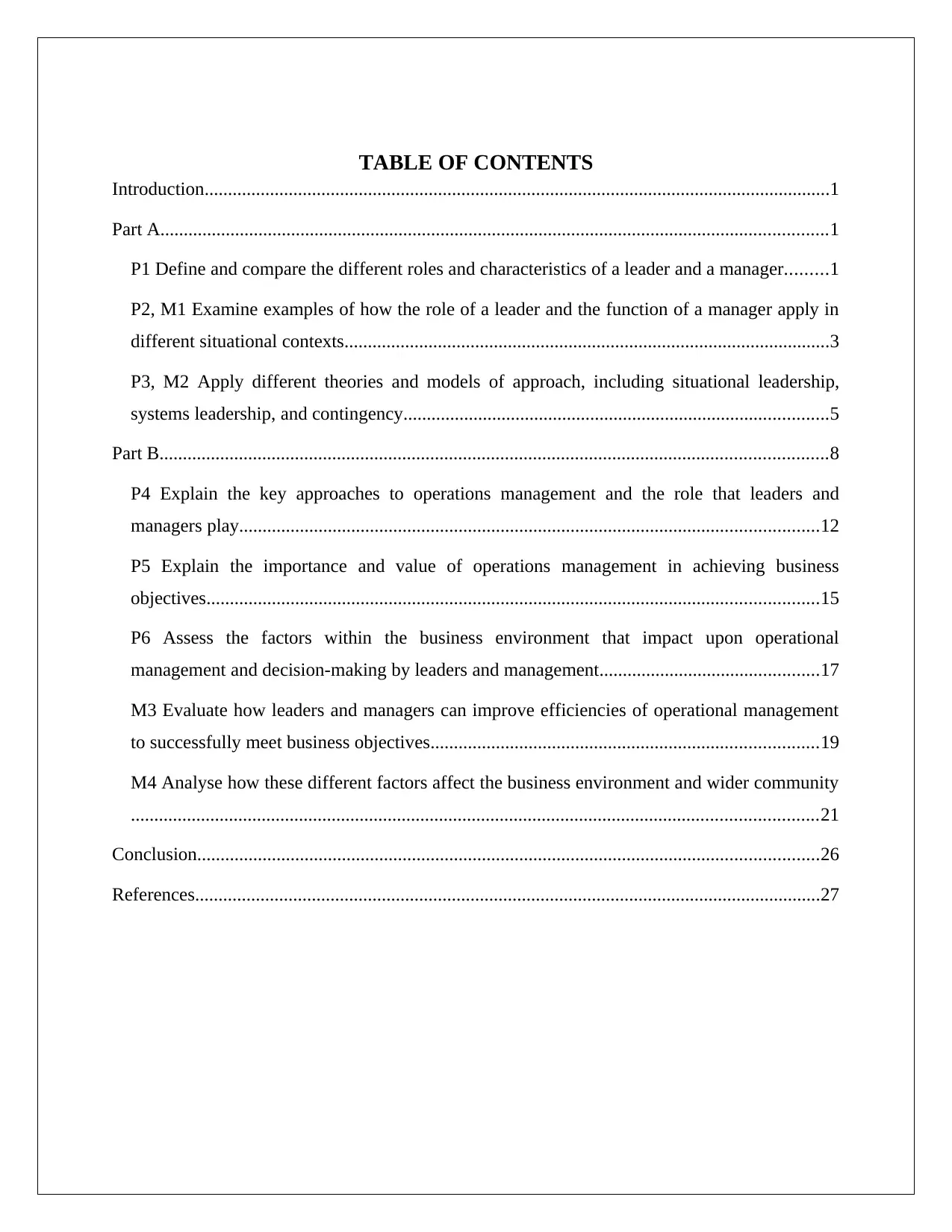
TABLE OF CONTENTS
Introduction......................................................................................................................................1
Part A...............................................................................................................................................1
P1 Define and compare the different roles and characteristics of a leader and a manager.........1
P2, M1 Examine examples of how the role of a leader and the function of a manager apply in
different situational contexts........................................................................................................3
P3, M2 Apply different theories and models of approach, including situational leadership,
systems leadership, and contingency...........................................................................................5
Part B...............................................................................................................................................8
P4 Explain the key approaches to operations management and the role that leaders and
managers play............................................................................................................................12
P5 Explain the importance and value of operations management in achieving business
objectives...................................................................................................................................15
P6 Assess the factors within the business environment that impact upon operational
management and decision-making by leaders and management...............................................17
M3 Evaluate how leaders and managers can improve efficiencies of operational management
to successfully meet business objectives...................................................................................19
M4 Analyse how these different factors affect the business environment and wider community
...................................................................................................................................................21
Conclusion.....................................................................................................................................26
References......................................................................................................................................27
Introduction......................................................................................................................................1
Part A...............................................................................................................................................1
P1 Define and compare the different roles and characteristics of a leader and a manager.........1
P2, M1 Examine examples of how the role of a leader and the function of a manager apply in
different situational contexts........................................................................................................3
P3, M2 Apply different theories and models of approach, including situational leadership,
systems leadership, and contingency...........................................................................................5
Part B...............................................................................................................................................8
P4 Explain the key approaches to operations management and the role that leaders and
managers play............................................................................................................................12
P5 Explain the importance and value of operations management in achieving business
objectives...................................................................................................................................15
P6 Assess the factors within the business environment that impact upon operational
management and decision-making by leaders and management...............................................17
M3 Evaluate how leaders and managers can improve efficiencies of operational management
to successfully meet business objectives...................................................................................19
M4 Analyse how these different factors affect the business environment and wider community
...................................................................................................................................................21
Conclusion.....................................................................................................................................26
References......................................................................................................................................27
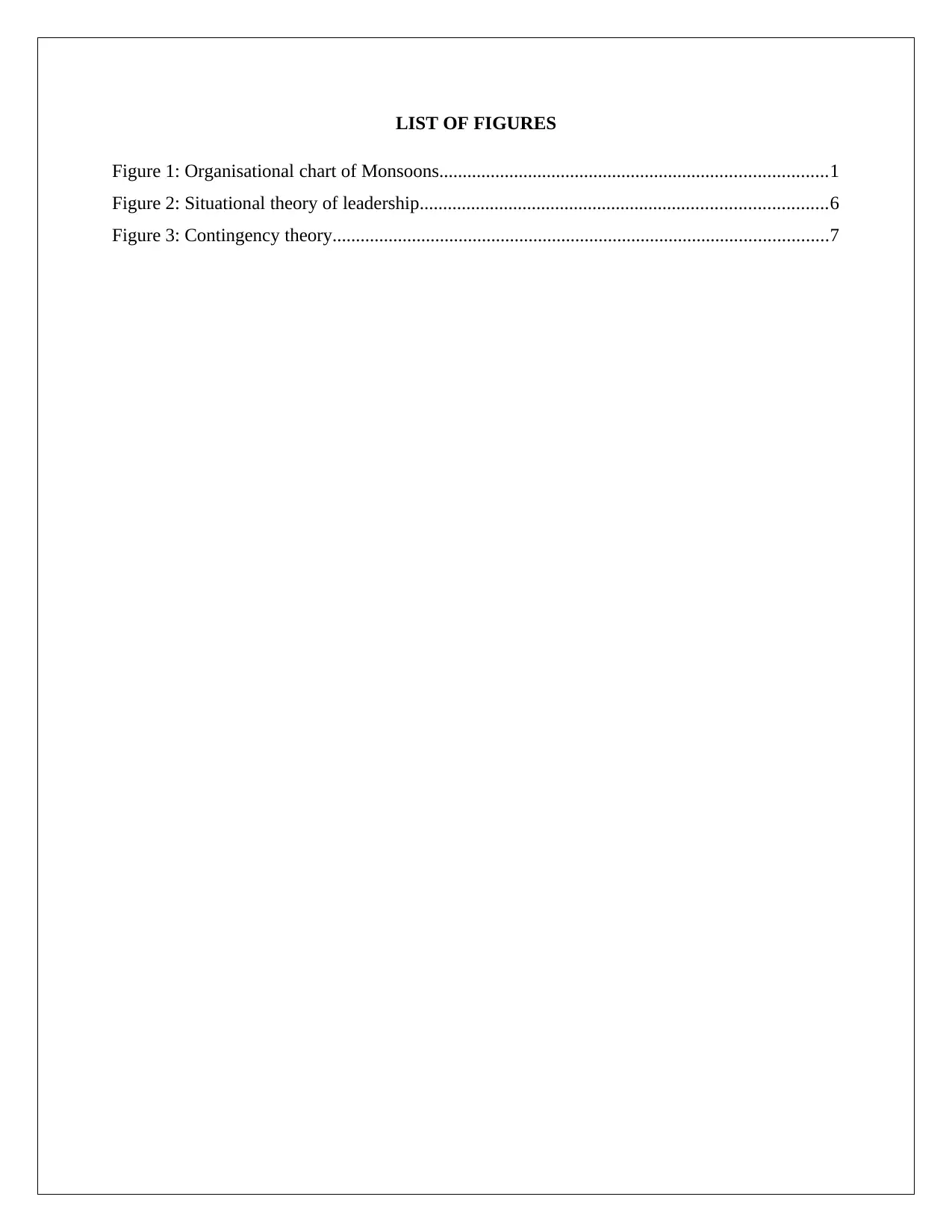
LIST OF FIGURES
Figure 1: Organisational chart of Monsoons...................................................................................1
Figure 2: Situational theory of leadership.......................................................................................6
Figure 3: Contingency theory..........................................................................................................7
Figure 1: Organisational chart of Monsoons...................................................................................1
Figure 2: Situational theory of leadership.......................................................................................6
Figure 3: Contingency theory..........................................................................................................7
⊘ This is a preview!⊘
Do you want full access?
Subscribe today to unlock all pages.

Trusted by 1+ million students worldwide

LIST OF TABLES
Table 1: Leadership VS management..............................................................................................2
Table 2: Manager and leaders in different situations.......................................................................4
Table 1: Leadership VS management..............................................................................................2
Table 2: Manager and leaders in different situations.......................................................................4
Paraphrase This Document
Need a fresh take? Get an instant paraphrase of this document with our AI Paraphraser
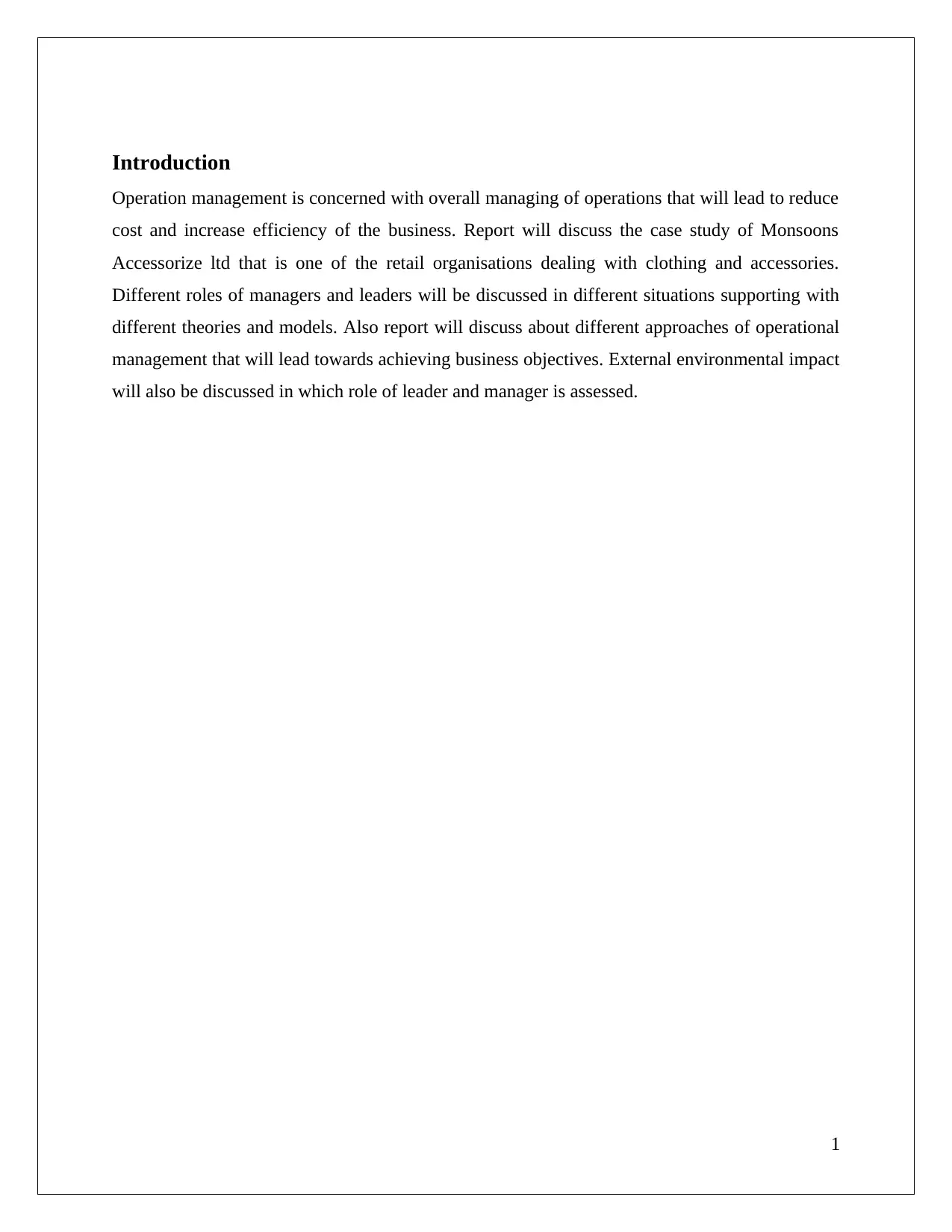
Introduction
Operation management is concerned with overall managing of operations that will lead to reduce
cost and increase efficiency of the business. Report will discuss the case study of Monsoons
Accessorize ltd that is one of the retail organisations dealing with clothing and accessories.
Different roles of managers and leaders will be discussed in different situations supporting with
different theories and models. Also report will discuss about different approaches of operational
management that will lead towards achieving business objectives. External environmental impact
will also be discussed in which role of leader and manager is assessed.
1
Operation management is concerned with overall managing of operations that will lead to reduce
cost and increase efficiency of the business. Report will discuss the case study of Monsoons
Accessorize ltd that is one of the retail organisations dealing with clothing and accessories.
Different roles of managers and leaders will be discussed in different situations supporting with
different theories and models. Also report will discuss about different approaches of operational
management that will lead towards achieving business objectives. External environmental impact
will also be discussed in which role of leader and manager is assessed.
1
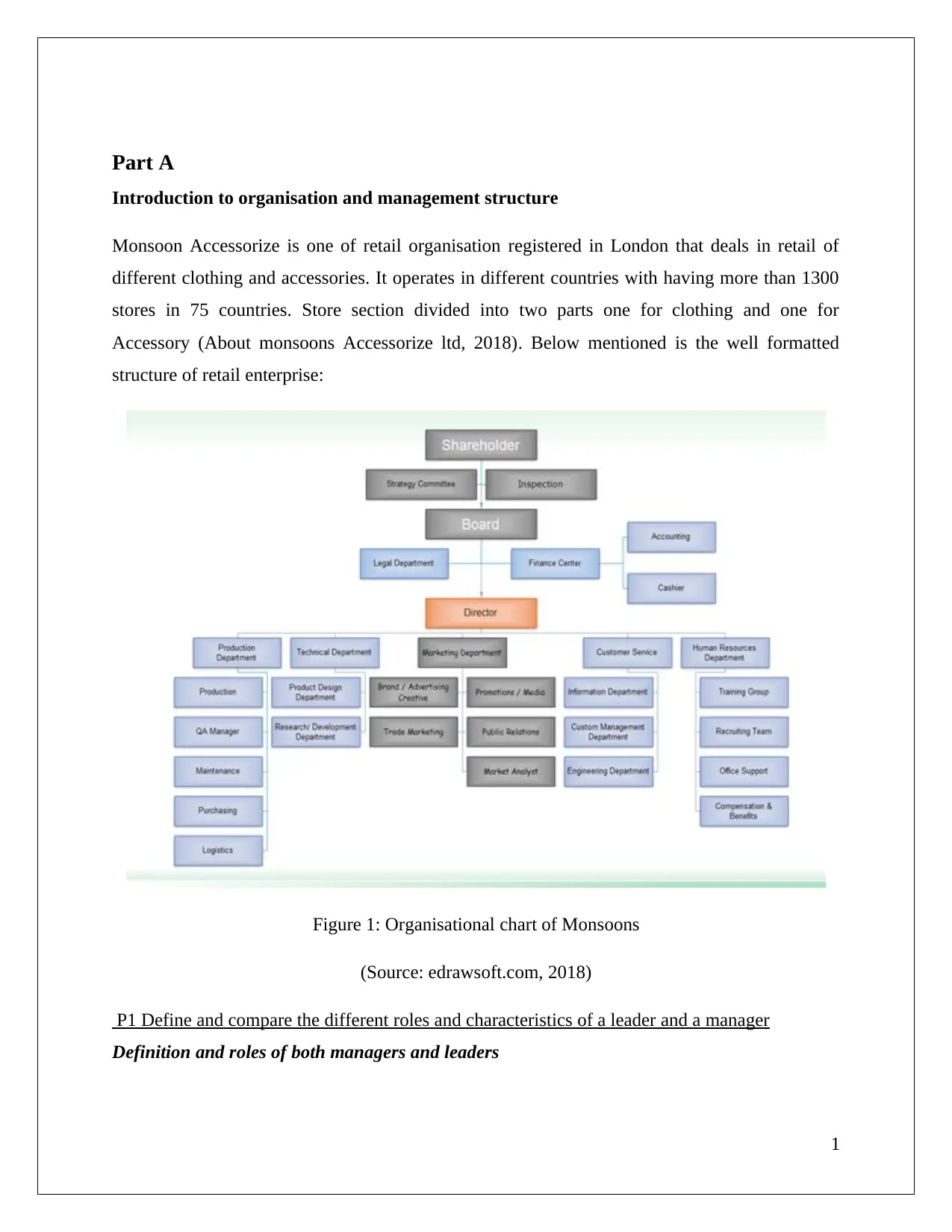
Part A
Introduction to organisation and management structure
Monsoon Accessorize is one of retail organisation registered in London that deals in retail of
different clothing and accessories. It operates in different countries with having more than 1300
stores in 75 countries. Store section divided into two parts one for clothing and one for
Accessory (About monsoons Accessorize ltd, 2018). Below mentioned is the well formatted
structure of retail enterprise:
Figure 1: Organisational chart of Monsoons
(Source: edrawsoft.com, 2018)
P1 Define and compare the different roles and characteristics of a leader and a manager
Definition and roles of both managers and leaders
1
Introduction to organisation and management structure
Monsoon Accessorize is one of retail organisation registered in London that deals in retail of
different clothing and accessories. It operates in different countries with having more than 1300
stores in 75 countries. Store section divided into two parts one for clothing and one for
Accessory (About monsoons Accessorize ltd, 2018). Below mentioned is the well formatted
structure of retail enterprise:
Figure 1: Organisational chart of Monsoons
(Source: edrawsoft.com, 2018)
P1 Define and compare the different roles and characteristics of a leader and a manager
Definition and roles of both managers and leaders
1
⊘ This is a preview!⊘
Do you want full access?
Subscribe today to unlock all pages.

Trusted by 1+ million students worldwide
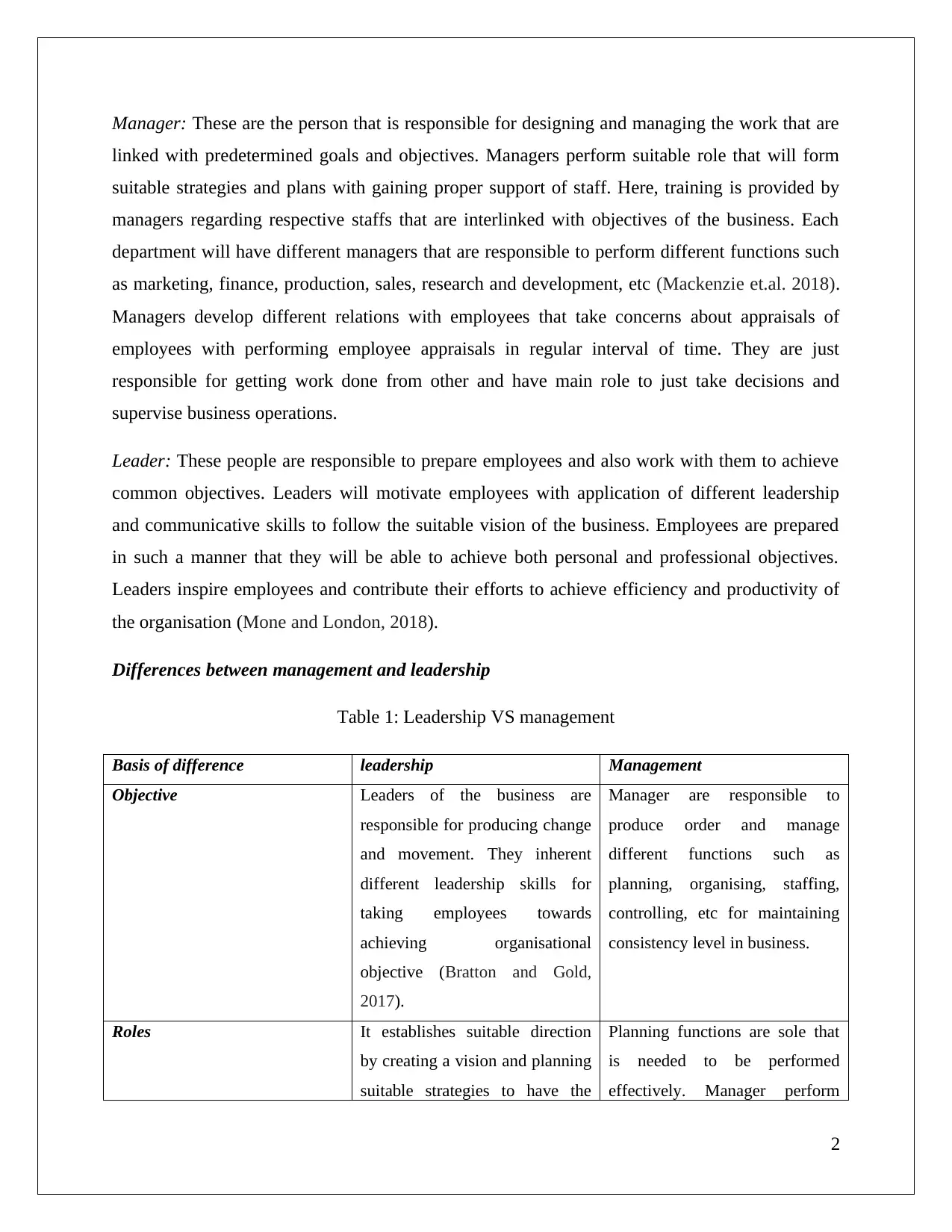
Manager: These are the person that is responsible for designing and managing the work that are
linked with predetermined goals and objectives. Managers perform suitable role that will form
suitable strategies and plans with gaining proper support of staff. Here, training is provided by
managers regarding respective staffs that are interlinked with objectives of the business. Each
department will have different managers that are responsible to perform different functions such
as marketing, finance, production, sales, research and development, etc (Mackenzie et.al. 2018).
Managers develop different relations with employees that take concerns about appraisals of
employees with performing employee appraisals in regular interval of time. They are just
responsible for getting work done from other and have main role to just take decisions and
supervise business operations.
Leader: These people are responsible to prepare employees and also work with them to achieve
common objectives. Leaders will motivate employees with application of different leadership
and communicative skills to follow the suitable vision of the business. Employees are prepared
in such a manner that they will be able to achieve both personal and professional objectives.
Leaders inspire employees and contribute their efforts to achieve efficiency and productivity of
the organisation (Mone and London, 2018).
Differences between management and leadership
Table 1: Leadership VS management
Basis of difference leadership Management
Objective Leaders of the business are
responsible for producing change
and movement. They inherent
different leadership skills for
taking employees towards
achieving organisational
objective (Bratton and Gold,
2017).
Manager are responsible to
produce order and manage
different functions such as
planning, organising, staffing,
controlling, etc for maintaining
consistency level in business.
Roles It establishes suitable direction
by creating a vision and planning
suitable strategies to have the
Planning functions are sole that
is needed to be performed
effectively. Manager perform
2
linked with predetermined goals and objectives. Managers perform suitable role that will form
suitable strategies and plans with gaining proper support of staff. Here, training is provided by
managers regarding respective staffs that are interlinked with objectives of the business. Each
department will have different managers that are responsible to perform different functions such
as marketing, finance, production, sales, research and development, etc (Mackenzie et.al. 2018).
Managers develop different relations with employees that take concerns about appraisals of
employees with performing employee appraisals in regular interval of time. They are just
responsible for getting work done from other and have main role to just take decisions and
supervise business operations.
Leader: These people are responsible to prepare employees and also work with them to achieve
common objectives. Leaders will motivate employees with application of different leadership
and communicative skills to follow the suitable vision of the business. Employees are prepared
in such a manner that they will be able to achieve both personal and professional objectives.
Leaders inspire employees and contribute their efforts to achieve efficiency and productivity of
the organisation (Mone and London, 2018).
Differences between management and leadership
Table 1: Leadership VS management
Basis of difference leadership Management
Objective Leaders of the business are
responsible for producing change
and movement. They inherent
different leadership skills for
taking employees towards
achieving organisational
objective (Bratton and Gold,
2017).
Manager are responsible to
produce order and manage
different functions such as
planning, organising, staffing,
controlling, etc for maintaining
consistency level in business.
Roles It establishes suitable direction
by creating a vision and planning
suitable strategies to have the
Planning functions are sole that
is needed to be performed
effectively. Manager perform
2
Paraphrase This Document
Need a fresh take? Get an instant paraphrase of this document with our AI Paraphraser
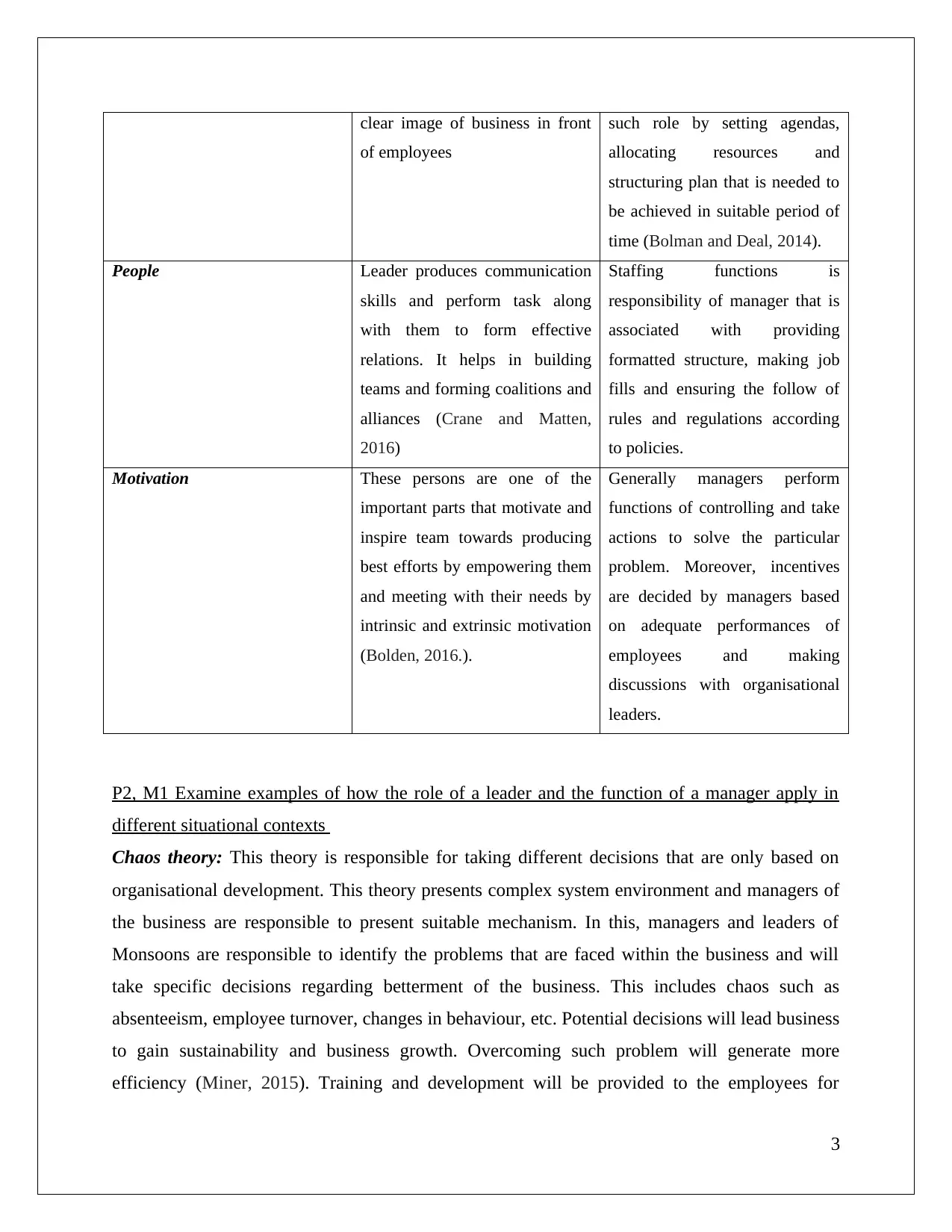
clear image of business in front
of employees
such role by setting agendas,
allocating resources and
structuring plan that is needed to
be achieved in suitable period of
time (Bolman and Deal, 2014).
People Leader produces communication
skills and perform task along
with them to form effective
relations. It helps in building
teams and forming coalitions and
alliances (Crane and Matten,
2016)
Staffing functions is
responsibility of manager that is
associated with providing
formatted structure, making job
fills and ensuring the follow of
rules and regulations according
to policies.
Motivation These persons are one of the
important parts that motivate and
inspire team towards producing
best efforts by empowering them
and meeting with their needs by
intrinsic and extrinsic motivation
(Bolden, 2016.).
Generally managers perform
functions of controlling and take
actions to solve the particular
problem. Moreover, incentives
are decided by managers based
on adequate performances of
employees and making
discussions with organisational
leaders.
P2, M1 Examine examples of how the role of a leader and the function of a manager apply in
different situational contexts
Chaos theory: This theory is responsible for taking different decisions that are only based on
organisational development. This theory presents complex system environment and managers of
the business are responsible to present suitable mechanism. In this, managers and leaders of
Monsoons are responsible to identify the problems that are faced within the business and will
take specific decisions regarding betterment of the business. This includes chaos such as
absenteeism, employee turnover, changes in behaviour, etc. Potential decisions will lead business
to gain sustainability and business growth. Overcoming such problem will generate more
efficiency (Miner, 2015). Training and development will be provided to the employees for
3
of employees
such role by setting agendas,
allocating resources and
structuring plan that is needed to
be achieved in suitable period of
time (Bolman and Deal, 2014).
People Leader produces communication
skills and perform task along
with them to form effective
relations. It helps in building
teams and forming coalitions and
alliances (Crane and Matten,
2016)
Staffing functions is
responsibility of manager that is
associated with providing
formatted structure, making job
fills and ensuring the follow of
rules and regulations according
to policies.
Motivation These persons are one of the
important parts that motivate and
inspire team towards producing
best efforts by empowering them
and meeting with their needs by
intrinsic and extrinsic motivation
(Bolden, 2016.).
Generally managers perform
functions of controlling and take
actions to solve the particular
problem. Moreover, incentives
are decided by managers based
on adequate performances of
employees and making
discussions with organisational
leaders.
P2, M1 Examine examples of how the role of a leader and the function of a manager apply in
different situational contexts
Chaos theory: This theory is responsible for taking different decisions that are only based on
organisational development. This theory presents complex system environment and managers of
the business are responsible to present suitable mechanism. In this, managers and leaders of
Monsoons are responsible to identify the problems that are faced within the business and will
take specific decisions regarding betterment of the business. This includes chaos such as
absenteeism, employee turnover, changes in behaviour, etc. Potential decisions will lead business
to gain sustainability and business growth. Overcoming such problem will generate more
efficiency (Miner, 2015). Training and development will be provided to the employees for
3
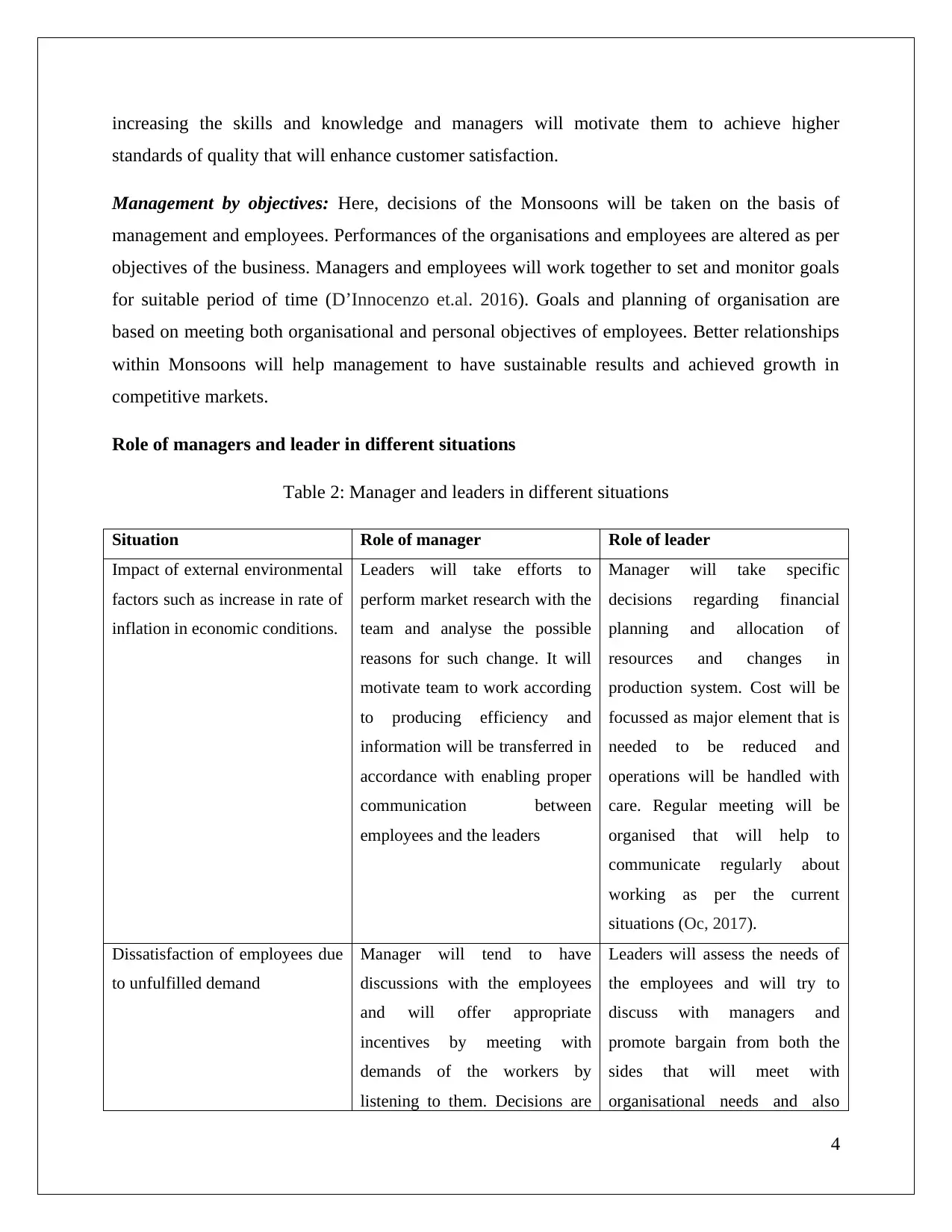
increasing the skills and knowledge and managers will motivate them to achieve higher
standards of quality that will enhance customer satisfaction.
Management by objectives: Here, decisions of the Monsoons will be taken on the basis of
management and employees. Performances of the organisations and employees are altered as per
objectives of the business. Managers and employees will work together to set and monitor goals
for suitable period of time (D’Innocenzo et.al. 2016). Goals and planning of organisation are
based on meeting both organisational and personal objectives of employees. Better relationships
within Monsoons will help management to have sustainable results and achieved growth in
competitive markets.
Role of managers and leader in different situations
Table 2: Manager and leaders in different situations
Situation Role of manager Role of leader
Impact of external environmental
factors such as increase in rate of
inflation in economic conditions.
Leaders will take efforts to
perform market research with the
team and analyse the possible
reasons for such change. It will
motivate team to work according
to producing efficiency and
information will be transferred in
accordance with enabling proper
communication between
employees and the leaders
Manager will take specific
decisions regarding financial
planning and allocation of
resources and changes in
production system. Cost will be
focussed as major element that is
needed to be reduced and
operations will be handled with
care. Regular meeting will be
organised that will help to
communicate regularly about
working as per the current
situations (Oc, 2017).
Dissatisfaction of employees due
to unfulfilled demand
Manager will tend to have
discussions with the employees
and will offer appropriate
incentives by meeting with
demands of the workers by
listening to them. Decisions are
Leaders will assess the needs of
the employees and will try to
discuss with managers and
promote bargain from both the
sides that will meet with
organisational needs and also
4
standards of quality that will enhance customer satisfaction.
Management by objectives: Here, decisions of the Monsoons will be taken on the basis of
management and employees. Performances of the organisations and employees are altered as per
objectives of the business. Managers and employees will work together to set and monitor goals
for suitable period of time (D’Innocenzo et.al. 2016). Goals and planning of organisation are
based on meeting both organisational and personal objectives of employees. Better relationships
within Monsoons will help management to have sustainable results and achieved growth in
competitive markets.
Role of managers and leader in different situations
Table 2: Manager and leaders in different situations
Situation Role of manager Role of leader
Impact of external environmental
factors such as increase in rate of
inflation in economic conditions.
Leaders will take efforts to
perform market research with the
team and analyse the possible
reasons for such change. It will
motivate team to work according
to producing efficiency and
information will be transferred in
accordance with enabling proper
communication between
employees and the leaders
Manager will take specific
decisions regarding financial
planning and allocation of
resources and changes in
production system. Cost will be
focussed as major element that is
needed to be reduced and
operations will be handled with
care. Regular meeting will be
organised that will help to
communicate regularly about
working as per the current
situations (Oc, 2017).
Dissatisfaction of employees due
to unfulfilled demand
Manager will tend to have
discussions with the employees
and will offer appropriate
incentives by meeting with
demands of the workers by
listening to them. Decisions are
Leaders will assess the needs of
the employees and will try to
discuss with managers and
promote bargain from both the
sides that will meet with
organisational needs and also
4
⊘ This is a preview!⊘
Do you want full access?
Subscribe today to unlock all pages.

Trusted by 1+ million students worldwide

taken under guidance of senior
management and that are always
for betterment of employees.
workers will also be motivated to
produce their best efforts within
the business.
P3, M2 Apply different theories and models of approach, including situational leadership,
systems leadership, and contingency
Situational leadership:
Situational theory is concerned with taking decisions in terms of considering different factors.
Such theory in context to Monsoons is explained below in detail:
Task behaviour: Different tasks are performed by employees and managers and leaders
are responsible to offer task on the basis of achieving organisational objectives. Task in
Monsoons are needed to be divided along with qualifications and skills of the employees.
Managers are responsible to create a competitive environment that will overcome the
conflict and differences within the organisation (Dubey et.al. 2017).
Relational behaviour: This includes management to form effective form of relationships
within the business that will lead to better decision making and efficiency is attained in
better manner.
Telling: In this, leaders are just responsible for providing guiding employees about their
roles and techniques to perform suitable task. Leader will not actually participate but will
guide employees to perform objectives in effective manner.
Participating: here, leaders are taking more participation and less guidance is offered to
the employees. However, staffs are invited to take decisions and come up with ideas for
achieving organisational productivity.
Selling: Leaders generally sell their direction and ideas and motivate them in such a
manner that will take active interest in achieving group and overall organisational
objectives (Grant, 2016).
Delegating: Decisions making is depended on staff members and leaders have no or less
involvement. Staff members tend to make several decisions and sole responsible to
perform their task in effective manner.
5
management and that are always
for betterment of employees.
workers will also be motivated to
produce their best efforts within
the business.
P3, M2 Apply different theories and models of approach, including situational leadership,
systems leadership, and contingency
Situational leadership:
Situational theory is concerned with taking decisions in terms of considering different factors.
Such theory in context to Monsoons is explained below in detail:
Task behaviour: Different tasks are performed by employees and managers and leaders
are responsible to offer task on the basis of achieving organisational objectives. Task in
Monsoons are needed to be divided along with qualifications and skills of the employees.
Managers are responsible to create a competitive environment that will overcome the
conflict and differences within the organisation (Dubey et.al. 2017).
Relational behaviour: This includes management to form effective form of relationships
within the business that will lead to better decision making and efficiency is attained in
better manner.
Telling: In this, leaders are just responsible for providing guiding employees about their
roles and techniques to perform suitable task. Leader will not actually participate but will
guide employees to perform objectives in effective manner.
Participating: here, leaders are taking more participation and less guidance is offered to
the employees. However, staffs are invited to take decisions and come up with ideas for
achieving organisational productivity.
Selling: Leaders generally sell their direction and ideas and motivate them in such a
manner that will take active interest in achieving group and overall organisational
objectives (Grant, 2016).
Delegating: Decisions making is depended on staff members and leaders have no or less
involvement. Staff members tend to make several decisions and sole responsible to
perform their task in effective manner.
5
Paraphrase This Document
Need a fresh take? Get an instant paraphrase of this document with our AI Paraphraser

Figure 2: Situational theory of leadership
(Source: technofunc.com, 2018)
System leadership:
Leaders seek for development of the structure of the organisation and also allocation suitable
resources to different departments. This structure is developed to divide the workload among
different departments and achieve targets with support and efficiency of employees. Monsoons
can apply this approach for mainly handling different functions of operational management.
Productive objectives can be achieved through meeting customer satisfaction. For example,
customer centric and goal oriented objectives can be attained with motivating employees to
greater extent with adjusting behaviour of the employees (Miner, 2015).
Contingency leadership:
This theory is concerned with considering both internal and external situations that impact on
different aims and objectives of the business. This theory is interplay between the application of
management and behaviours in specific situations that depends upon the circumstances. In this,
6
(Source: technofunc.com, 2018)
System leadership:
Leaders seek for development of the structure of the organisation and also allocation suitable
resources to different departments. This structure is developed to divide the workload among
different departments and achieve targets with support and efficiency of employees. Monsoons
can apply this approach for mainly handling different functions of operational management.
Productive objectives can be achieved through meeting customer satisfaction. For example,
customer centric and goal oriented objectives can be attained with motivating employees to
greater extent with adjusting behaviour of the employees (Miner, 2015).
Contingency leadership:
This theory is concerned with considering both internal and external situations that impact on
different aims and objectives of the business. This theory is interplay between the application of
management and behaviours in specific situations that depends upon the circumstances. In this,
6
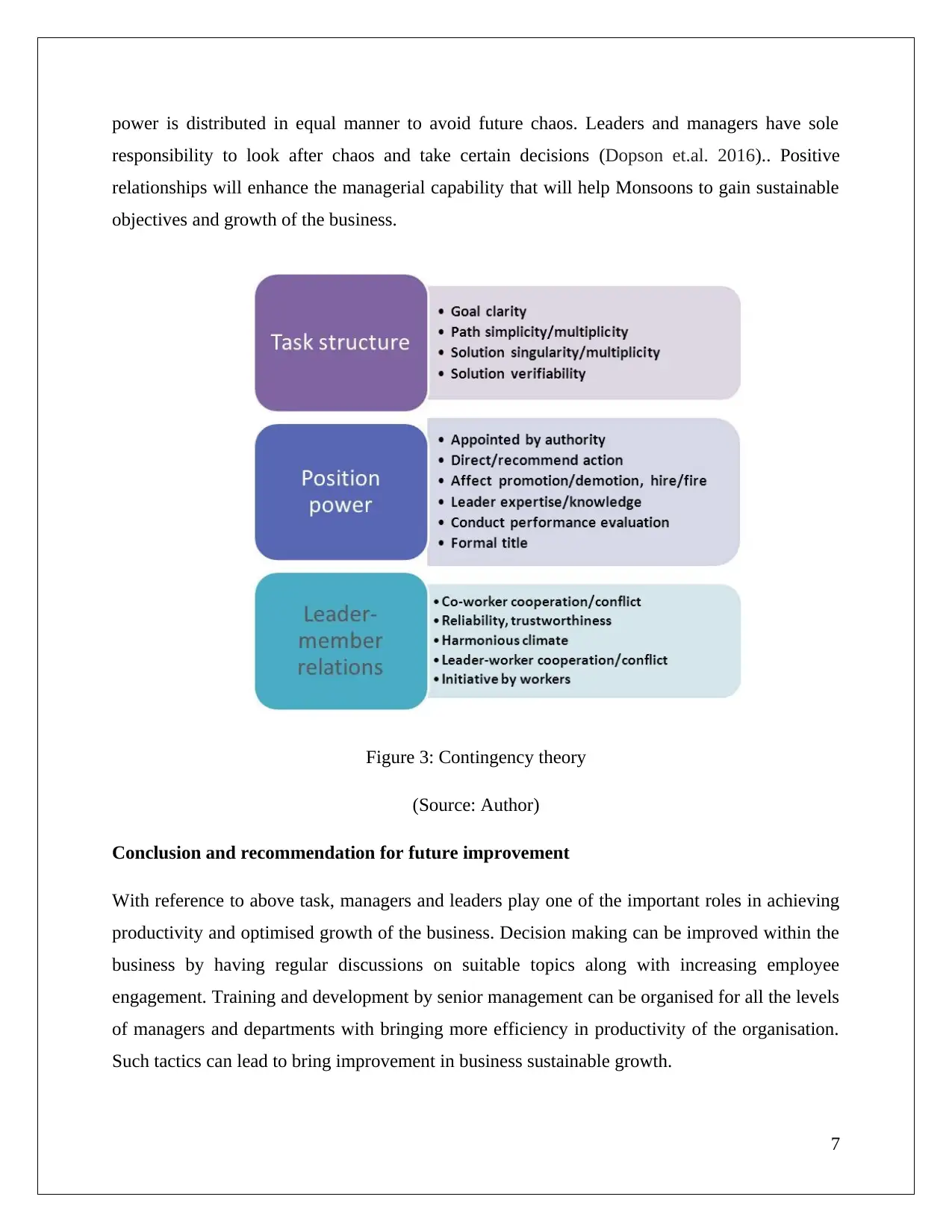
power is distributed in equal manner to avoid future chaos. Leaders and managers have sole
responsibility to look after chaos and take certain decisions (Dopson et.al. 2016).. Positive
relationships will enhance the managerial capability that will help Monsoons to gain sustainable
objectives and growth of the business.
Figure 3: Contingency theory
(Source: Author)
Conclusion and recommendation for future improvement
With reference to above task, managers and leaders play one of the important roles in achieving
productivity and optimised growth of the business. Decision making can be improved within the
business by having regular discussions on suitable topics along with increasing employee
engagement. Training and development by senior management can be organised for all the levels
of managers and departments with bringing more efficiency in productivity of the organisation.
Such tactics can lead to bring improvement in business sustainable growth.
7
responsibility to look after chaos and take certain decisions (Dopson et.al. 2016).. Positive
relationships will enhance the managerial capability that will help Monsoons to gain sustainable
objectives and growth of the business.
Figure 3: Contingency theory
(Source: Author)
Conclusion and recommendation for future improvement
With reference to above task, managers and leaders play one of the important roles in achieving
productivity and optimised growth of the business. Decision making can be improved within the
business by having regular discussions on suitable topics along with increasing employee
engagement. Training and development by senior management can be organised for all the levels
of managers and departments with bringing more efficiency in productivity of the organisation.
Such tactics can lead to bring improvement in business sustainable growth.
7
⊘ This is a preview!⊘
Do you want full access?
Subscribe today to unlock all pages.

Trusted by 1+ million students worldwide
1 out of 34
Related Documents
Your All-in-One AI-Powered Toolkit for Academic Success.
+13062052269
info@desklib.com
Available 24*7 on WhatsApp / Email
![[object Object]](/_next/static/media/star-bottom.7253800d.svg)
Unlock your academic potential
Copyright © 2020–2025 A2Z Services. All Rights Reserved. Developed and managed by ZUCOL.




